The Power Of X
A simple yet powerful lighting technique anyone can master in under a minute.
A simple yet powerful lighting technique anyone can master in under a minute.
By Tim Park

LEDs come in all types of shapes and sizes. There are panels, bulbs, ribbons, and COB (“chip on board”) fixtures often found in fresnel type point-source lights. For a long time these LEDs were single-color, balanced to either tungsten or daylight. However this year as we tested over 165 LED lights at the annual NAB trade show to update our comprehensive LED database, we found that over half of the LEDs at the show were bicolor. This was an incredible change from last year when there were only a handful.
The idea behind bicolor LED lights is that there are tungsten balance LEDs and daylight balanced LEDs mixed within the same fixture. By adjusting the intensity of each type of emitter, the entire range of color temperature spectrum between the two LED classes is now available to the filmmaker. This way a filmmaker just needs one type of light that they can dial in to match incandescent practicals, or the sun outside, or brands of single-color lights that have color temps that are a bit off, etc.
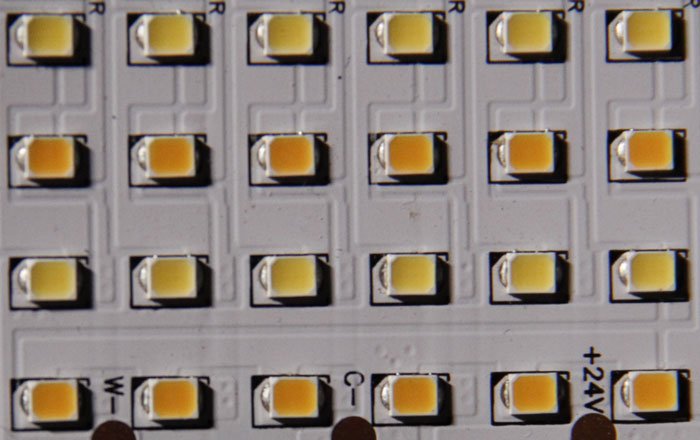
Initially this sounds like a wonderful idea, which is probably why so many LED manufacturers are doing it. They already have each type of LED, all they have to do now is repackage them into the same fixture and allow the user to dim them independently. Some manufacturers even provide a readout so you know where on the color temperature range the you are. (Word of caution: most of these readouts are off by 200 K and often even more.)
The more I thought about the intricacies of creating a bicolor LED, the more I wondered if this was even good for film and video makers. Mixing two dissimilar lights does not necessarily create a useful blended light.
Tungsten light is based on blackbody principles, where a blackbody emits visible light if you heat it up enough. As it gets hotter and hotter, the color balance of the light changes, going from a more orange color to a more blue color. This is where the idea of correlated color temperature (CCT) come from, and why the units are kelvin (K), which is a measure of temperature. Looking at the spectrum from a true tungsten light source shows how full and even the color spectrum is.
However, daylight is VERY different. While the sun is a great light source, that light is significantly changed as it goes through our atmosphere. It’s why the sky is blue, the clouds are white, and the sunsets are so full of reds and oranges. This explains why the color temperature of daylight depends on time of day and if you are in the sunlight or in the shade, and if it is cloudy or completely sunny. In fact tungsten light and “daylight” are so different that the color quality is measured using very different standards. These standards — called “standard illuminants” — abruptly change at 5000K, which is why all spectrometers give very odd graphics and data as you cross over this temperature point; below 5000K CIE Standard Illuminant A is used, at and above 5000K CIE Standard Illuminant D65 is used. (More on the abrupt change below, in the section titled “Specific R-Values.”)
So if a LED manufacturer plans to mix these two types of light together, what happens when they both are on at full intensity to give you the color temperatures in the middle? In our video “Are LEDs Ruining Your Projects” we show the problems you can have if you mix different brands of LEDs together without doing any camera tests first. And the LED lights in that experiment were all supposedly daylight-balanced. Throw in some tungsten LEDs and very new problems could potentially crop up.
Let’s say the LED manufacturer decides to modify their phosphor formulations so that the resulting mixed light is still useable. What does this do to the tungsten and daylight extremes of the color range? The tungsten and daylight ends might now be lower quality as the manufacturer compromises the LEDs.
What is a filmmaker to do…
With the potential for so many problems with bicolor LEDs, and with so many brands building them, it was imperative to figure out what is going on along the entire bicolor range, as well as what happens when those lights are dimmed.
So I took a bicolor LED from one of the top LED manufacturers on the market and ran some tests. Yuji International is a huge innovator in LED phospors and are not shy about putting all the data from their LEDs right there on their website. So if they can pull off bicolor LED lights, there is hope. If they can’t, well…
(Note: We are not affiliated with Yuji International in any way, and gain nothing by mentioning their lights or linking to them. They have twice sent us small samples of LEDs free of charge for our tests, but that is it.)
Yuji International sent me a half-strip of their BC Series 12x Multirow LEDs (24V). The BC Series is a line of high CRI LEDs that Yuji sells in different forms, from bulbs to COB emitters to different sized ribbons. However, it isn’t their highest CRI line. Their VTC Series of LEDs has even better CRI values since they use a violet die instead of a blue die to excite the phosphors, and then add blue phosphors to the mix to still get the blue values. However Yuji does not have bicolor lights in their VTC Series, so the BC Series Hybrid was going to have to do. Still, it is a great line of LED so this was not a problem.
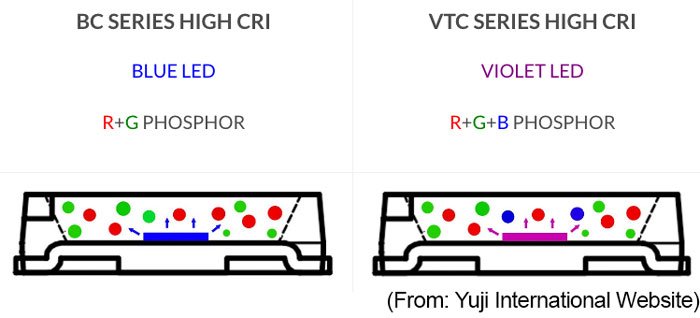
We have previously tested the VTC line, which is currently ranked at the top of our database of 165 LED lights. The BC Series being reviewed in this article ranked 2.0 points lower, which is still excellent.
 Price (USD): $120 (Yuji Int’l) |
Yuji BC Series Multirow Hybrid Product Page (Measured 5/2016) 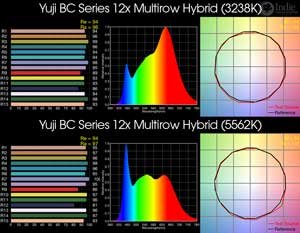 |
||||||
| Rank | Color (CCT) | CRI (Ra) | CRI (Re) | TLCI | CQS | Rf | Rg |
| 96.5 | 3238 | 95.8 | 94.2 | 98.9 | 97 | 94 | 102 |
| 5562 | 96.5 | 94.5 | 98.2 | 94 | 93 | 102 | |
In a blacked out studio the Yuji LED sample was positioned vertically with black duvetyne placed directly behind it to block any reflections from the C-stand it was mounted on. We mounted an Asensetek Lighting Passport SMART Spectrometer to another C-stand so the spectrometer sensor was exactly 1 meter in front of the LED ribbon light pointing directly at the light. The spectrometer was synced to the Spectrum Genius app to collect and process the data from the meter. We attached two Yuji Flicker-Free Power Supplies (24V) to the bicolor strip since each color — tungsten and daylight — needs to be powered separately.
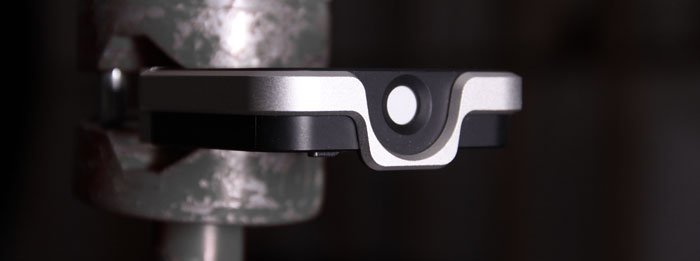
For the first test the tungsten emitters were set to full power with the daylight emitters off. The daylight emitter were then barely turned on and their brightness gradually increased so that the resulting mixed light increased in approximately 200K increments. Once the daylight emitters were at maximum brightness, the tungsten emitters were gradually turned down so the mixed light continued in 200K increments until the tungsten emitters were completely off.

The second test involved increasing only the tungsten emitters in ten evenly spaced increments on the effective range of the power supply dial. (Note: the knob had to be turned about 33% before any emitters were illuminated. Furthermore, maximum brightness was reached at about 66% on the dial, with no change in light quality seen for the remainder of the range of the knob. This was observed for both power supplies and both the tungsten and daylight emitters.)
The third test was like the second except was only with the daylight emitters.

The fourth test was to increase both the tungsten and daylight emitters at the same rate so that the color temperature remained at 4100K at all brightness levels. This is the effective midpoint of the emitters as seen when both types are at maximum power.
For both extremes of the bicolor range — 2700K and 6500K — when only the tungsten-diodes or only the daylight emitters are illuminated, the correlated color temperature (CCT) was very stable as the LEDs were dimmed.
When both types of emitter (tungsten and daylight) are combined, as color temperature increases, brightness increases and decreases in a predictable fashion.
Therefore, color measurements are highly accurate and repeatable in a near-linear fashion. This makes sense since the color spectra are additive in both color and brightness. (It is not exactly linear because the black body locus is a curve. So while the bicolor LED is truly linear, when referenced to the curve the result is reported as a slight deviation near the midpoint.) Since the color temperature within the range is stable with dimming, and the spectra are additive, and the midrange increases and decreases predictably, it is safe to assume dimming won’t affect overall color temperature. (Some individual colors do drift a bit with dimming, which we discuss in the section “Specific R-Values.”)
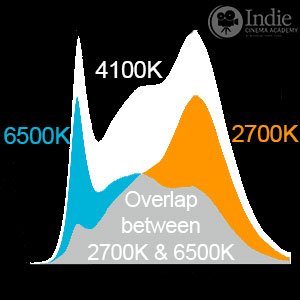
To demonstrate how each LED diode is additive, I’ve overlaid the 2700K and the 6500K spectra with the spectrum at 4100K, which is when both emitters are at their maximum. While this diagram shouldn’t be taken analytically — since the maximum from each spectrum is relative and not quantitative — you can see how the middle of the 2700K and 6500K spectra could add together to create the 4100K spectrum. (Since each spectrum has a relative y-axis that is adjusted to the dominant wavelength, I distorted the vertical axis of the 2700K and 6500K spectra to have a more correct relationship with the 4100K spectrum, which is much brighter than either of these two spectra.)
Adding daylight emitters to tungsten increases the color temperature almost 1400K, from 2730K to 4100K. In contrast, adding tungsten to daylight emitters decreases the color temp 2400K; daylight-only has a color temp of 6478K. Furthermore, the daylight emitters are 17% brighter than tungsten at 1 meter, 709 lux and 612 lux respectively. Therefore the tungsten emitters seem to have more influence over color temp, despite not being as bright. Possible the manufacturer made the daylight emitters brighter to increase their influence.
Conclusion this far: it appears that the tungsten and daylight LEDs in this bicolor LED are behaving very well.
The spectra across the complete bicolor range remains very broad with no major dips. Additionally at the tungsten end — 2700K and 3200K — there are no major peaks other than the red peak which should be there. The mid-range 4100K spectrum as well as those at the daylight end (5600K and 6500K) show a strong blue peak, which ideally wouldn’t be there but is normal for LEDs. The blue peak is because the phosphors in most LEDs are triggered with a blue LED. However this blue peak isn’t extreme and so doesn’t significantly affect the color quality so it is acceptable. So everything is looking good.
As we mention in the “How To Read The Results” section of our article explaining our LED database, the TM-30-15 is based on 99 colors samples. When reading the graphic, take note to see how well the red line traces the reference’s black circle. The TM-30-15 graphics suggest that the tungsten end has higher fidelity of color (Rf) and that it slightly decreases as the bicolor LED moves toward the daylight end of the range. Additionally the middle of the range has a little higher gamut (Rg), meaning the color is a slightly more saturated. There are barely any hue-shifts (shown with green arrows) on the tungsten end and in the middle of the temperature range. However in the 5600K and 6500K graphics you can see some larger hue-shifts in the reds. Nothing earth shattering, but it explains the decrease in color fidelity. But I’m still very impressed with the results.
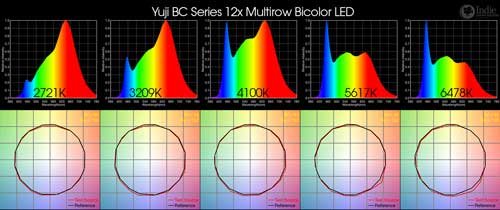
Both CRI (Ra) and CRI (Re) dip when both emitters are illuminated equally (2.8 and 4.6, respectively) resulting in 4100K light– which is on the warmer side of the CCT midpoint – while both types of emitters have excellent color alone. As mentioned earlier, the dip is due to the black body locus being a curve, so the linear behavior of the bicolor as it is tuned results in some deviation around 4000K. In both CRI (Ra) and CRI (Re) this decrease is from the R1, R2, R5, R6, and R8 values, as is discussed below in the section “Specific R-Values.” This dip is increased in CRI (Re) heavily by the behavior of the saturated red (R9) value, as well as saturated yellow (R10) and the medium skin tone (R15) values, while only slightly from the light skin tone (R13). Obviously saturated blue (R12) also is involved, but in different ways. Therefore, emitters might have been optimized for working alone and not when mixed.
(Check out the complete display and naming of the CRI (Ra) and CRI (Re) colors.)
Across the entire color temperature range, TCLI tends to give the highest values of all color quality scales. Despite this both TLCI and CQS drop as color temp increases above 3000K (1.7 and 5, respectively). If these color quality scales are important for your production, such as if you are in television broadcast, you will want to favor the tungsten side of the range.
When the bicolor are mixed evenly (4100K), CRI (Ra), CRI (Re), TLCI, and CQS all increase as brightness increases (3.3, 3.8, 1.1, and 2, respectively). Therefore, for mixed light, brighter light might result in higher color quality.
With tungsten emitters, all color scales increase as brightness increases (CRI (Ra): 2.8; CRI (Re) 3.1; TLCI: 2.8; and CQS: 5). Daylight emitters behave similarly, with Ra, Re, and TLCI all increasing with brightness (2.8, 2.9, and 2.1), although CQS is unchanged. Therefore all mixtures of light have better overall color quality as brightness increases.
All of the individual values that make up CRI (Ra) — R1 through R8 — are above 91 for the entire color temperature range. Therefore this scale might not fully reveal all that is going on with the color spectrum.
Within the additional R-values that make up CRI (Re) — R9 through R15 — much more variation is seen: R9 (saturated yellow), R10 (saturated red), R12 (saturated blue), and R15 (medium skin color) all change dramatically over the color temperature range. The R9 value is the most significant as it drops 17 points at the midpoint of the color temperature range, before returning nearly to where it started. This means that if you are filming skin tones or objects containing saturated red, you should stick with either full tungsten or full daylight. R12 also drops 17 points as the color temperature increases, but it never recovers. This means that, ironically, the saturated blue is much better with the tungsten end than the daylight end of the range. The other two big movers – R10 and R15 – both dip and recover about 8 points.
Something to note is that right at 5000K some R-values show a jagged move either up or down. Sharp examples of this are with R8, R11, R12, although a few others show it slightly. This is because the correlated color temperature standard illuminant changes right at 5000K, and so spectrometers switch to a different calculation at this point. It isn’t that the color suddenly gets better or worse at this point, it is just that the reference point changes.
Since much of this change happens at the color temperature midpoint, we looked to see how dimming the LED affected the color quality. Saturated red (R9) and saturated yellow (R10) both continue to decrease as the LED is dimmed at 4100K, dropping an additional 9.5 and 10 points, respectively, from full brightness to just above zero brightness. This is also seen with saturated blue (R12) at 4100K, which drops 7.5 points as it is dimmed to zero. Other R-values also drop as the LED is dimmed at 4100K, so if you are working in the middle of the color temperature range you will probably want to work at full brightness and decrease the brightness using other methods, just as diffusion or neutral density (ND) filters.
This decrease in R10, and R12 is also seen in the tungsten and daylight ends of the color temperature range. At the tungsten end, R10 and R12 both decrease 6.5 points upon dimming down to zero, while at the daylight end R10 drops 3 points and R12 drops 5 points.
As I suspected, the tungsten and daylight LEDs produced much higher quality color individually than anything produced when when mixing them. Melding dissimilar lights brings in too many variables to control. That being said, this specific bicolor LED still did a fantastic job at producing high quality light.
Looking at the big picture, the light from the Yuji BC Series Hybrid LED is better than many other LED lights on the market. In fact, take the worst light from this LED — let’s say at 4100K when CRI (Ra), CRI (Re) and the saturated red values (R9) are all at their lowest — and say that is the only light this LED produces. It is still on par with single-color LEDs that are ranked only a couple points below where this LED is ranked as a bicolor. So from this perspective this bicolor LED does very well across its entire color temperature range, it’s just that the front and end of the range are the best. Additionally, as mentioned earlier, at all color temperatures this specific bicolor LED does better at full brightness.
This gives me hope. Yes, this light is from one of the best on the market. Lower quality brands still have plenty of opportunity to screw up their bicolors. But these results show that bicolor LEDs can be a very useful tool for those who need to constantly adjust the color temperature of their lights. And since LED technology is still in its relatively infancy, the future is very bright. When I look at all the improvements in phosphors and other LED technology just in the past 12 months, I’m excited to see what shows up at NAB next year. Perhaps many of lingering problems will be fixed!
Also, not all bicolor LEDs will behave as this one did. Some might produce better color quality when dimmed. Or different specific colors might struggle or do better. Remember that these results are only for this bicolor LED.
Do you agree? Perhaps you have a very different perspective. Let us know your thoughts by leaving a comment in the comment section below!
You must be logged in to post a comment.
This site uses Akismet to reduce spam. Learn how your comment data is processed.

This site uses cookies. By continuing to browse the site, you are agreeing to our use of cookies.
AcceptHide notification onlySettingsWe may request cookies to be set on your device. We use cookies to let us know when you visit our websites, how you interact with us, to enrich your user experience, and to customize your relationship with our website.
Click on the different category headings to find out more. You can also change some of your preferences. Note that blocking some types of cookies may impact your experience on our websites and the services we are able to offer.
These cookies are strictly necessary to provide you with services available through our website and to use some of its features.
Because these cookies are strictly necessary to deliver the website, refusing them will have impact how our site functions. You always can block or delete cookies by changing your browser settings and force blocking all cookies on this website. But this will always prompt you to accept/refuse cookies when revisiting our site.
We fully respect if you want to refuse cookies but to avoid asking you again and again kindly allow us to store a cookie for that. You are free to opt out any time or opt in for other cookies to get a better experience. If you refuse cookies we will remove all set cookies in our domain.
We provide you with a list of stored cookies on your computer in our domain so you can check what we stored. Due to security reasons we are not able to show or modify cookies from other domains. You can check these in your browser security settings.
We also use different external services like Google Webfonts, Google Maps, and external Video providers. Since these providers may collect personal data like your IP address we allow you to block them here. Please be aware that this might heavily reduce the functionality and appearance of our site. Changes will take effect once you reload the page.
Google Webfont Settings:
Google Map Settings:
Google reCaptcha Settings:
Vimeo and Youtube video embeds:
You can read about our cookies and privacy settings in detail on our Privacy Policy Page.
Privacy Policy
Very great comprehensive posts about led, why you do not create a study about kinoflo and different manufacturers, with explanation to the theory behind it like your wonderful LED demystify .
Thank you!
We are working on examining a few different brands of bicolor LEDs. Unfortunately, each study takes A LOT of work since there is so much about bicolor lights to examine. Additionally, the newest tech in LEDs is using RGB LEDs as well as other LED blending so that all color temps have higher color quality. This takes the analysis to an even higher level.
Currently we’re doing a thorough color analysis of two Fiilex LEDs: P100 and Q1000. The Fiilex Q1000 has hue adjustment, meaning you can add magenta or green to correct for any hue shifts. Amazing! (I know Kino, Arri, and a few other brands also have this available.) This is a huge benefit to the consumer. LEDs have come a long way, and are starting to beat out other tech such as HMIs and fluorescent as far as color quality.
HI. Thanks for this, good knowledge. Do you have any experience about Cree`s leds (their high end cobs especially)?
I´m starting to build a DIY – led set with high cri (focus on R12-15 rendering) and 5600K.
Mainly used for interviews, short films etc (all small indie products). So the skin color rendering is the most important thing to me.
I`ve been reading all about Yuji and Cree, but I`m more of a cinematographer than technician and only have hands-on experience shooting video with a low budget led lights. Like Godox 5600 video light(cob) and Aputure Amaran dual color panel(emitters).
And I´ll need a lot of lumens. All who knows how sofbox and grid in front eats the light, knows that “there`s never too much light”. Excluding the sun.
We haven’t tested any of CREE’s COBs. However, looking at their informational sheet of the Cree CXA3070 (PDF) it looks like the CRI values are really terrible for that model. On Page 6 of this PDF they show that the tungsten balanced version has a CRI of 93, but gets increasingly worse as it goes toward daylight balanced. This might just be a lower quality model, but I’m wondering if many of the Cree LEDs would have the same problem. Last year we tested one of Cree’s household bulbs (60W) and it didn’t do very well: while the CRI adequate (91.4), the the saturated red (R9) value was 61.9, which is not that great. So if skin tones are important to you, you might want to look elsewhere. Yuji does have some COB’s but be sure to check the specs before settling on one. The R9 for the Yuji BC-400H 100W COB is only 70, while R9 for the Yuji BC-270H 500W COB is 90. Obviously these two COBs are apples and oranges, since the first one is just the chip and the second one has the heatsink radiator built-in.
Lumens are a separate issue, but also important. Some companies focus on lumens and neglect color, others focus on color and neglect lumens. The balance is tricky since adding phosphors to get good color results in filtering some of the light — especially for tungsten balanced LEDs since they have to block a lot of the blue light, which is the wavelength that excites the phosphors to start with. So your best bet if you need color quality AND lumens is to go with a panel LED or a fresnel style. This way more the light is directed more where you need it.
Thanks. First plan was to do couple of panels using HQ led-strips, but friend of mine who will be building these lights with me, introduced cobs as an alternative option. Mainly because of the high lum power and easy to build coolers/heatsinks.
That Cree`s model, Xlamp CXA3070 you`re pointing at, seems to be a model from few years back.
This newer Cree cob, Xlamp CXA2 Studio LED is a best option we have found so far (ok, maybe the Yuji could beat this, but we`re also in a tight budget):
http://www.cree.com/~/media/Files/Cree/LED-Components-and-Modules/XLamp/Data-and-Binning/ds-CXA2.pdf
Do you have any experience/analysis about that one?
I couldn`t find any info about R9-15 values from the sheet (or can`t read/get it).
(and just to mention, I´m not after any specific manufacture. Only trying to find a best color rendering options for DIY in a budget, to not to waist our time to build bad lights)
Appreciate for your help.
The spectrum for the CXA2 (Page 5 of the PDF you linked to) looks much better than the CXA3070. What I’m specifically looking at is the valley that always shows up around 480nm. For the CXA2 there really isn’t much of a valley, which is very good since it means you have those wavelengths to work with. There is also some decent strength above 660nm so you should have some red wavelengths to work with too. (This is just a rough guess from looking at their graphs.)
COBs are relatively new, so the tech is still being refined. The physics and engineering behind it is a bit different than smaller emitters. It’s too bad that the R9-R15 values aren’t published anywhere. Manufacturers across the entire LED industry tend to not be as forthright about these numbers (especially when the values aren’t great), but that is slowly changing as filmmakers become better educated.
Also, kudos on building your own gear. I always encourage filmmakers to at least try to build some of their equipment. There is so much learned in the process.
Let me know once you’re finished building your light and let me know how it goes!
Thank you for posting this analysis, it has been very helpful for me! I’m using Yuji LEDs now on some projects (not for film or photography) and had them custom make me some strips with lower color temperature for mixing. What I’ve found that explains some of what you are finding is that in CIE1931 xy chromaticity space, the linear mixing of different color temp LEDs doesn’t follow the black body locus so it deviates from the ideal. I believe this is why RGB is beginning to be used in addition (particularly green) to improve the CRI of the mix. I also think this is why Philips made quite a big deal about its lime green diodes, as it should feasibly do a better job than saturated green due to the broader spectrum. With properly programmed dimming levels you could feasibly bump it up to match the BBL as you adjust color temperature This becomes particularly relevant for mixing of extremes on the low color temperature end, where the BBL takes a nosedive down in y. Conversely, mixing between 3000k-6000k the BBL more closely resembles a straight line, and the mix behaves more appropriately.
I’m in the process now of trying to work with the extremes, and my experiments show that mixing of 2 channels of even 100 CRI light causes deviations as explained above. At some point it becomes cost prohibitive, but with the likes of Yuji (and others now also following suit with 95+ CRI whites at reasonable price) I have great hope that 3+ channel mixing with the right diodes (possibly 3 white channels, or 2 white and a lime green), with properly programmed dimming levels for color temp adjustments is around the corner, even for homeowners!
You are very correct! Higher end bicolor LEDs are starting to have hue control that add green/magenta to better dial in the midpoints between 3000K and 6000K so they follow the black body locus (BBL) more accurately. Two examples include Fiilex Q1000 and Kino Flo Diva-Lite LED 20 DMX. Blending traditional bicolors moves the temperature along a straight line between the two extremes. Since you really need a curve, the midpoint is where the greatest deviation is. By adding in the hue adjustment, it basically becomes a third dimension (toward and away from the curve, since it is green/magenta), to bring each temperature back to the curve.
Interesting report for numeric values based on standards that relate to the eye but what about tests based on the cameras perception? I have worked with a variety of light sources for years on camera and used DSC labs charts and vector scopes to evaluate. I would line the camera to a specific K using a continuous radiator source such as tungsten that gives a true K reading. After that I would put my other light source on the chart and compare the two sources. I could then see the shift or defenecies in the second light source based on the image sensors. With bicolour LED it was easy to see if I could dial in a match and if not how off it was. All based on the image sensors I was using. Since I was only concerned on how the camera saw the light I could filter or adjust as needed until my primaries secondaries and skin tones were accurate on the vector scope. The DSC labs charts are have saturation so you need 2X gain on vector scope. This allowed me to evaluate the light and match it on camera if possible. Lining up to a source in isolation is possible even with poor CRI but it is the sources ability to be corrected to match the main lined up source that is a concern for me. Good R9 is meaningless for camera compared to SMPTE red in the box on a vectorscope. Skin tone should be on the line. This testing accounts for the characteristics of the different image sensors something CRI TLCI CQS does not.
Good thoughts, Brad, as always!
It is always good for all filmmakers to test their lights with the camera they are using for a project when color has to be spot on. This way the light and camera can be dialed in to correct for any colors that are off. With our tests, it is impossible to even start to test lights against each camera sensor on the market. So we use the standard color rendering measurements currently on the market to give filmmakers some context for each light. This way they don’t grab a light that clearly doesn’t emit a specific color and then expect that color to magically happen through gels and grading.
It might be interesting to evaluate some Hive Plasma lights (Wasp and Bee) and compare them to LEDs in general…, and/or the Wasp 100-C LED. I don’t know if dimming is feasible with the Plasma lights.
I wish it was possible to add Lux or Lumen data at consistent distances for the lights you analyze. Even better would be a downloadable spreadsheet or pdf I could copy and paste into a spreadsheet so I could sort the columns by TLCI, Lux or Lumens and Cost to determine the “Best Value”. That would help me make firm/informed decisions instead of $10k or $20k (lighting budget) worth of guesswork… One could select the 95 Average, or greater rated lights and determine the “buck-a-lux” bang for each light.
I would worship you for eternity after having spent about several thousand hours searching the internet trying to make sense out of the inconsistent B&H Specs, Manufacturers websites and Videos for all of the beam angles and different distances in meters or feet, etc…
I found some conversion websites where changing the beam angle and distance will give you LUX from a Lumen number, or Lumens to LUX depending on the Manufacturer/Product specs. The data could be compared if you believe the number(s) you start with. And, of course, that requires personally measuring the TLCI (which the camera sees) of every fixture, and knowing the beam angle. I don’t know if that could be done in a reasonable time-frame, but I think you are the only group who might be dedicated enough and capable of it. Clearly, you are an immeasurably valuable resource already (I just discovered your website…) and I feel like Christopher Colombus, LOL.
Thanks for your incredible work. I am waiting to see your new data for the NAB lights you mentioned (homepage?) I do not think it is likely you will actually create a spreadsheet from which I can copy the data, but after I see the 95 Average (or better) list, I may actually try to do it myself, and I will send it to you if I succeed.
Very good thoughts! We will try to come up with a spreadsheet so you can refine your own personal searches. Tricky part is that we’ve already had other blogs and organizations try to steal all of our work and pass it off as their own. We are hear to help and sharing and trust is part of that. It is just sad that some in the community focus on making a buck off of other’s work.
Remember that lumens and lux are measuring VERY different things: lumens measures total light output from the source, even when it is going in the opposite direction you want; lux measures light intensity passing through an area in the direction you want it to go. Now that that is clarified, the sad news is that for most lights we don’t collect useful lux data. This is because we are doing many measurements during trade shows, so distances from the light fixture to our spectrometer is never consistent. For color quality, this doesn’t matter. But for intensity it does. Additionally, beam angle (as you mentioned) is another issue. With traditional tungsten bulbs, angle was only an issue if there it was a PAR fixture or there was a fresnel lens of some type. But in the world of LEDs, beam angle is different for every model of light. This is because many panel LEDs have little clear lenses on each diode, which redirects the light into a specific beam angle. This requires creating multiple measurements at 1 meter, 2 meters, and 3 meters and posting those results. For lights we bring back to the studio we already take these measurements. But this is only a fraction of the LED database.
We are still crunching the results from NAB 2017 fixtures. We are halfway done and will start posting finished results as they happen. First fixtures will probably start getting posted early June.
Are there any cheap ways to have a dimmer that adjusts temperature with one dial and overall brightness with the other? I am searching myself to death right now.
That’s a tricky questions since the process is actually…tricky. With bicolor LEDs, changing the color temperature requires increasing one set of LEDs (let’s say the daylight balanced emitters), while at the same time decreasing the other set of LEDs (in this case the tungsten balanced diodes). Same goes with dimming the fixture as a whole, increasing both sets or decreasing both sets.
We have evaluated over 400 LED fixtures for our LED Database (currently we still have another 200 fixtures to post the results from…very laborious process), and we’ve noticed that a lot of brands have different ways to deal with the problem you address. The most common way is to have the color in one dial, the dimming in another dial. This requires some circuitry and programming within the fixture to calculate out. The reason is that it isn’t a one-to-one blending. At the color extremes things change more rapidly than in the middle of the range. Other companies have separate dials for the color sets and the operator has to do the blending and dimming by eye.
For this article we used dimmers from Yuji International, and had to have TWO dimmers one for each color temperature. This is really the main way you’ll have to go with ribbon LEDs, at least right now. I have not seen combined dimmers for ribbon lights, although I have to admit I haven’t looked since my main focus with LEDs is finished fixtures. So it is no surprise that your searching has not come up with anything. (It could be an opportunity for someone to innovate a product…hint, hint.)
Litegear actually sells a 400USD dimmer for bicolor lights. Also Hint taken, I will try to come up with something. 🙂
Yes, and Litegear is an amazing brand. However $400 (USD) is not exactly cheap.
So if you are debating between buying descent quality daylight LEDs that require a filter to get other colors vs. LEDs that are bicolored, what would be the best option?
That is an excellent question! I used to say get the daylight. But now that bicolors are getting so much better, that would be a great option too. The deciding factor involves how bright you need it to be. Bicolors need to “split the real estate,” meaning if you are going to go all-daylight very often the light will not be as bright. Additionally, even in the middle of the CCT the brightness levels often aren’t as bright as a mildly gelled daylight since the tungsten-LEDs in the bicolor technically are already filtered daylights.
Thanks for explaining that bicolor LED lights are tungsten and daylight lights mixed. I have a shoot I am working on, and getting lights like this would be really convenient to get. I’ll have to look up more about this type of light and find a way to incorporate it into my set.
They are a specialized LED. There are down sides to bi-color, such as less light output at the extremes because the panel is “sharing real estate” with the other LED diodes. So only get bi-color if you need to have a range of color temperature options at your disposal.
Thanks for sharing !
Such a good article !
Tim,
As somebody who is completely new to lighting, but trying to learn for some YouTube videos, this has been immensely helpful. My question to you is for interviews, and product reviews that will be mostly done in my home, where there are many windows, is bicolor the option you would choose? If so I am considering the two following options. FYI, my “budget” can’t really afford the Kala series, but something tells me you will say save and wait.
(https://dracobroadcast.com/brands/dracast/light-kits/s-series-plus-kits/)
(https://dracobroadcast.com/brands/dracast/light-kits/kala-series-light-kits/)
Thank you,
Joshua
Glad our articles and reviews are helping you, Joshua.
Since you mentioned having a lot of windows, you will most likely wanting to match the light coming through them. So I wonder if buying daylight balanced LEDs is a better option. Bicolor is useful when you have odd “white” lights that you are trying to match, or when you want to give a more blue or orange tone to something. But with interviews and product reviews, filmmakers tend to just create a consistent white and balance their cameras to that.
The Dracast lights you linked to with definitely do the job. The biggest difference between the two series are size: 500 LED diodes vs. 1000 or 2000 LED diodes. This is why the Kala series costs nearly double the S-Series. But don’t blow your budget on lights when you are just starting out, since you’ll need to purchase or rent other gear. So going with the S-series is fine.